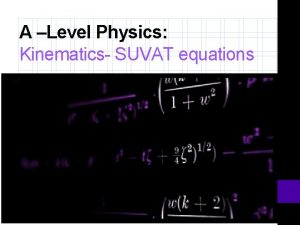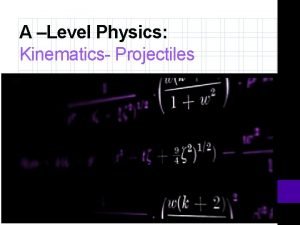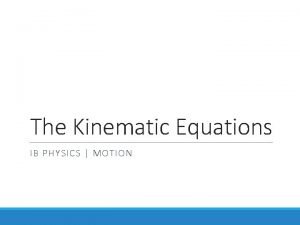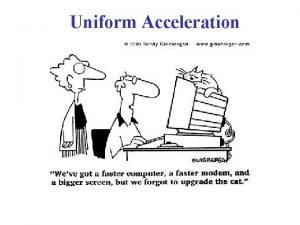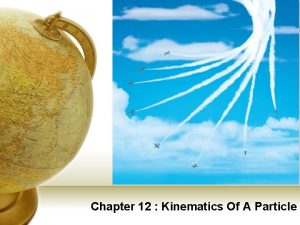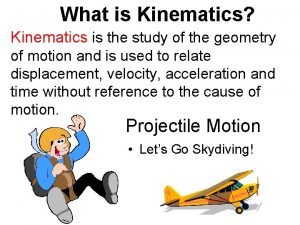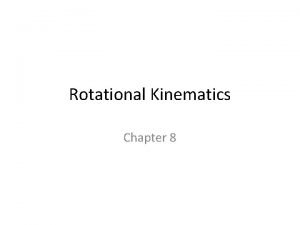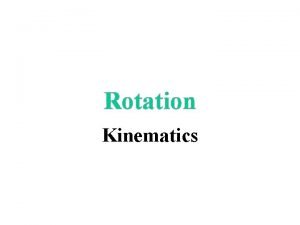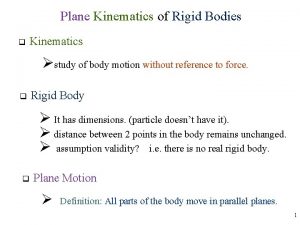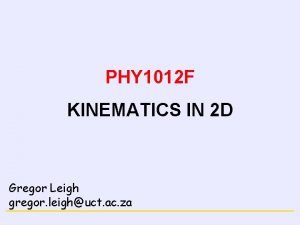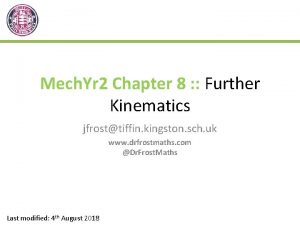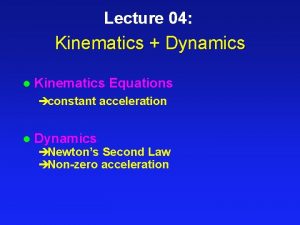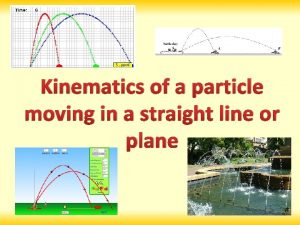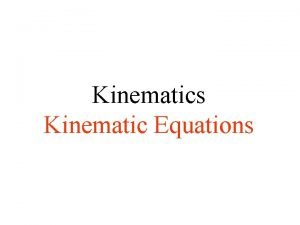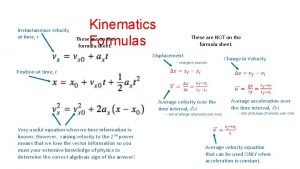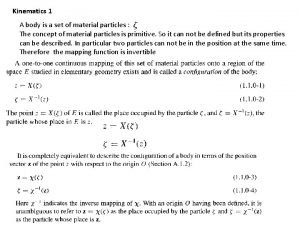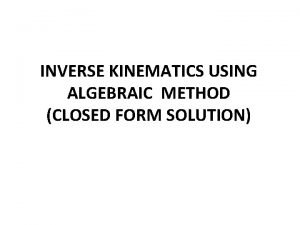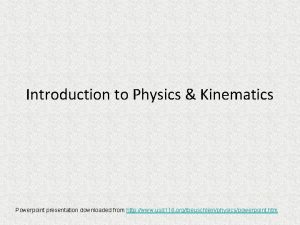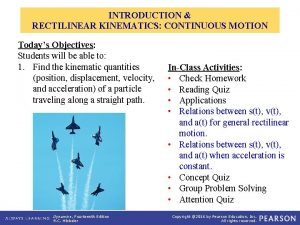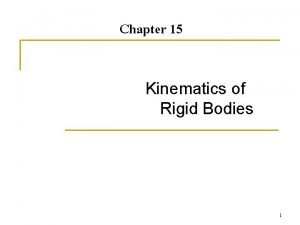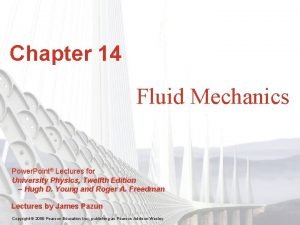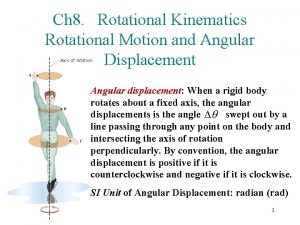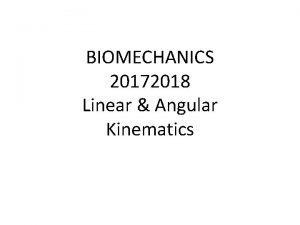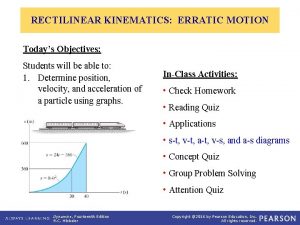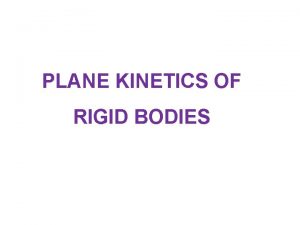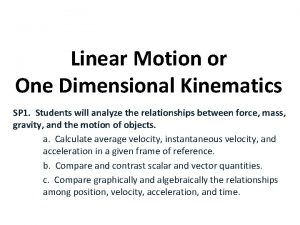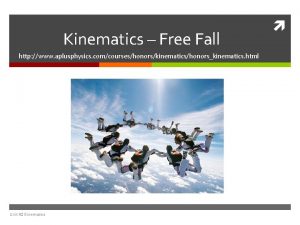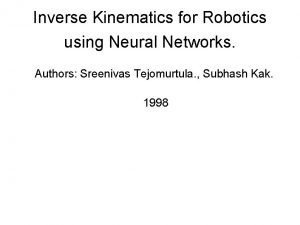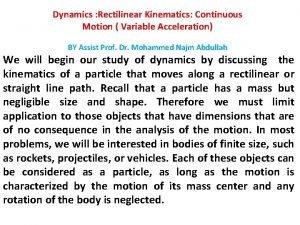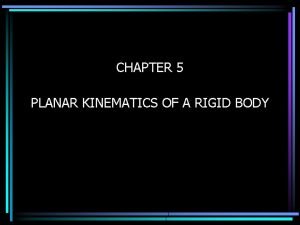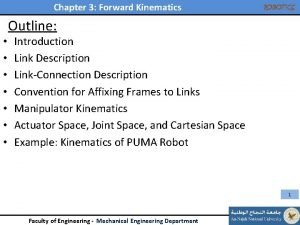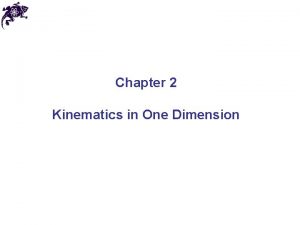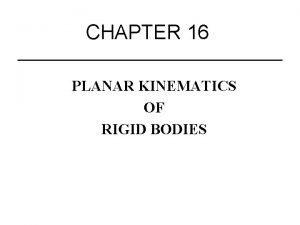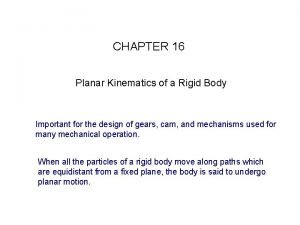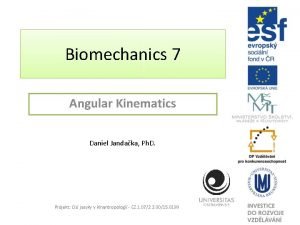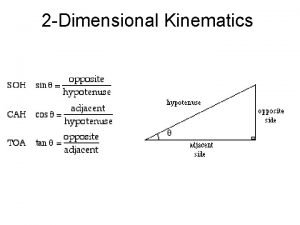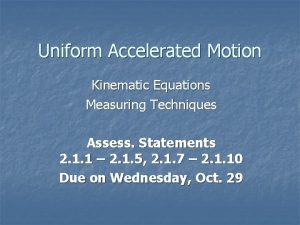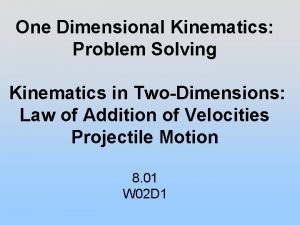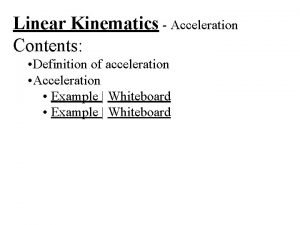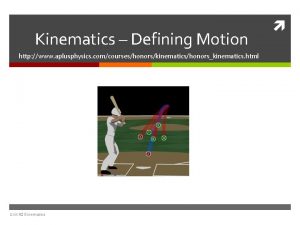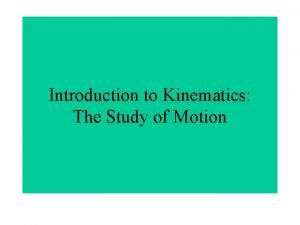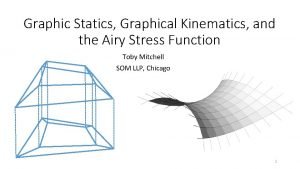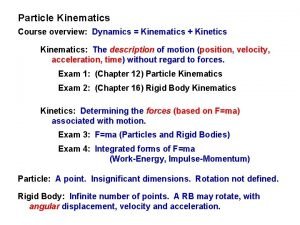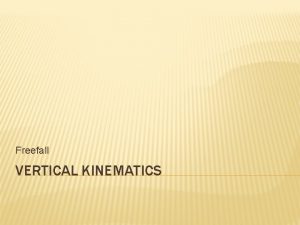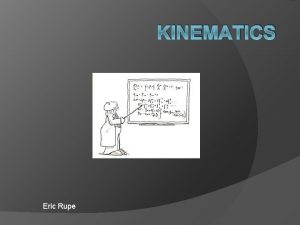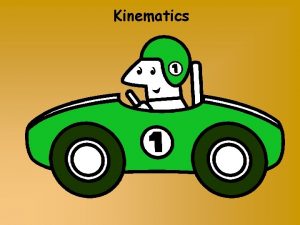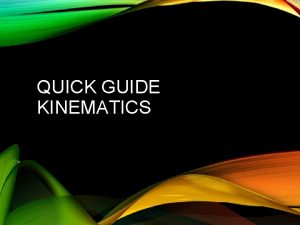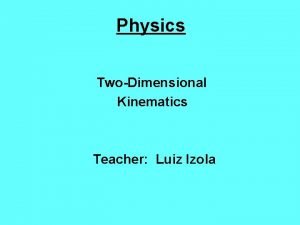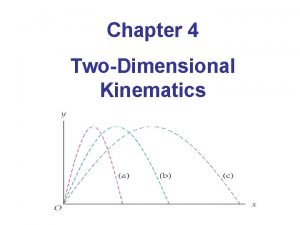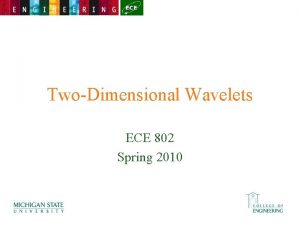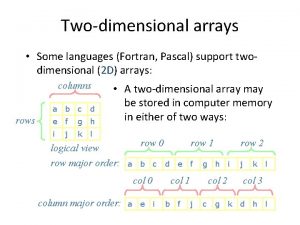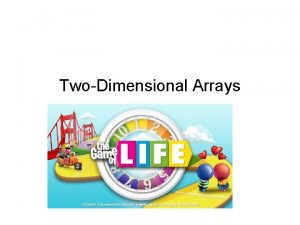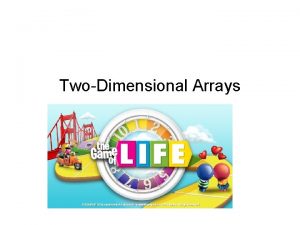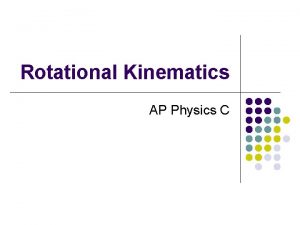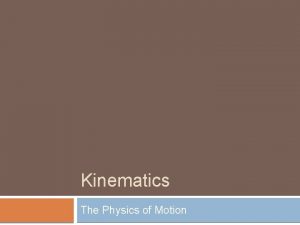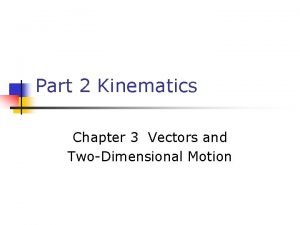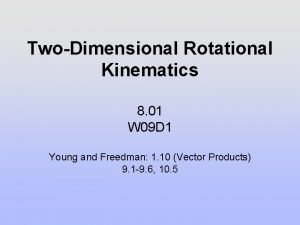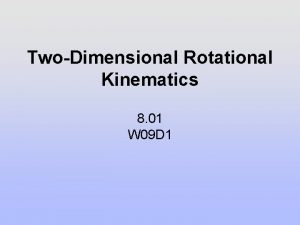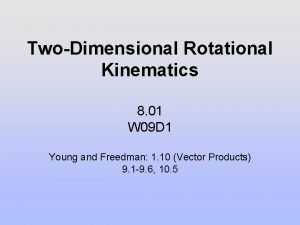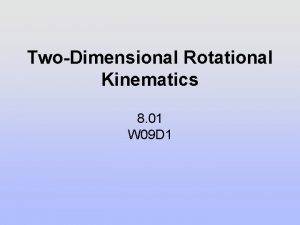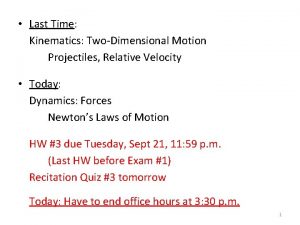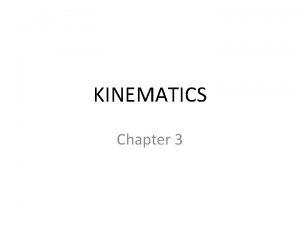COLLEGE PHYSICS Chapter 3 TWODIMENSIONAL KINEMATICS Power Point






























































- Slides: 62

COLLEGE PHYSICS Chapter 3 TWO-DIMENSIONAL KINEMATICS Power. Point Image Slideshow

FIGURE 3. 1 Everyday motion that we experience is, thankfully, rarely as tortuous as a rollercoaster ride like this —the Dragon Khan in Spain’s Universal Port Aventura Amusement Park. However, most motion is in curved, rather than straight-line, paths. Motion along a curved path is two- or three-dimensional motion, and can be described in a similar fashion to one-dimensional motion. (credit: Boris 23/Wikimedia Commons)

FIGURE 3. 2 Walkers and drivers in a city like New York are rarely able to travel in straight lines to reach their destinations. Instead, they must follow roads and sidewalks, making twodimensional, zigzagged paths. (credit: Margaret W. Carruthers)

FIGURE 3. 3 A pedestrian walks a two-dimensional path between two points in a city. In this scene, all blocks are square and are the same size.

FIGURE 3. 4

FIGURE 3. 5 The straight-line path followed by a helicopter between the two points is shorter than the 14 blocks walked by the pedestrian. All blocks are square and the same size.

FIGURE 3. 6 This shows the motions of two identical balls—one falls from rest, the other has an initial horizontal velocity. Each subsequent position is an equal time interval. Arrows represent horizontal and vertical velocities at each position. The ball on the right has an initial horizontal velocity, while the ball on the left has no horizontal velocity. Despite the difference in horizontal velocities, the vertical velocities and positions are identical for both balls. This shows that the vertical and horizontal motions are independent.

FIGURE 3. 8 Displacement can be determined graphically using a scale map, such as this one of the Hawaiian Islands. A journey from Hawai’i to Moloka’i has a number of legs, or journey segments. These segments can be added graphically with a ruler to determine the total two-dimensional displacement of the journey. (credit: US Geological Survey)

FIGURE 3. 9 A person walks 9 blocks east and 5 blocks north. The displacement is 10. 3 blocks at an angle 29. 1º north of east.

FIGURE 3. 10 To describe the resultant vector for the person walking in a city considered in Figure 3. 9 graphically, draw an arrow to represent the total displacement vector D. Using a protractor, draw a line at an angle θ relative to the east-west axis. The length D of the arrow is proportional to the vector’s magnitude and is measured along the line with a ruler. In this example, the magnitude D of the vector is 10. 3 units, and the direction θ is 29. 1º north of east.

FIGURE 3. 11 Head-to-Tail Method: The head-to-tail method of graphically adding vectors is illustrated for the two displacements of the person walking in a city considered in Figure 3. 9. (a) Draw a vector representing the displacement to the east. (b) Draw a vector representing the displacement to the north. The tail of this vector should originate from the head of the first, east-pointing vector. (c) Draw a line from the tail of the east-pointing vector to the head of the north-pointing vector to form the sum or resultant vector D. The length of the arrow D is proportional to the vector’s magnitude and is measured to be 10. 3 units. Its direction, described as the angle with respect to the east (or horizontal axis) θ is measured with a protractor to be 29. 1º.

FIGURE 3. 12

FIGURE 3. 13

FIGURE 3. 14

FIGURE 3. 15

FIGURE 3. 16

FIGURE 3. 17

FIGURE 3. 18

FIGURE 3. 19

FIGURE 3. 20 The negative of a vector is just another vector of the same magnitude but pointing in the opposite direction. So B is the negative of –B ; it has the same length but opposite direction.

FIGURE 3. 21

FIGURE 3. 22

FIGURE 3. 23

FIGURE 3. 24

FIGURE 3. 26 The vector A , with its tail at the origin of an x, y-coordinate system, is shown together with its x- and y-components, Ax and Ay. These vectors form a right triangle. The analytical relationships among these vectors are summarized below.

FIGURE 3. 27 The magnitudes of the vector components Ax and Ay can be related to the resultant vector A and the angle θ with trigonometric identities. Here we see that Ax = A cos θ and Ay = A sin θ.

FIGURE 3. 28 We can use the relationships Ax = A cos θ and Ay = A sin θ to determine the magnitude of the horizontal and vertical component vectors in this example.

FIGURE 3. 29 The magnitude and direction of the resultant vector can be determined once the horizontal and vertical components Ax and Ay have been determined.

FIGURE 3. 30 Vectors A and B are two legs of a walk, and R is the resultant or total displacement. You can use analytical methods to determine the magnitude and direction of R.

FIGURE 3. 31 To add vectors A and B , first determine the horizontal and vertical components of each vector. These are the dotted vectors Ax , Ay , Bx and By shown in the image.

FIGURE 3. 32 The magnitude of the vectors Ax and Bx add to give the magnitude Rx of the resultant vector in the horizontal direction. Similarly, the magnitudes of the vectors Ay and By add to give the magnitude Ry of the resultant vector in the vertical direction.

FIGURE 3. 33 Vector A has magnitude 53. 0 m and direction 20. 0 º north of the x-axis. Vector B has magnitude 34. 0 m and direction 63. 0º north of the x-axis. You can use analytical methods to determine the magnitude and direction of R.

FIGURE 3. 34 Using analytical methods, we see that the magnitude of R is 81. 2 m and its direction is 36. 6º north of east.

FIGURE 3. 35 The subtraction of the two vectors shown in Figure 3. 30. The components of –B are the negatives of the components of B. The method of subtraction is the same as that for addition.

FIGURE 3. 37 The total displacement s of a soccer ball at a point along its path. The vector s has components x and y along the horizontal and vertical axes. Its magnitude is s , and it makes an angle θ with the horizontal.

FIGURE 3. 38 (a) We analyze two-dimensional projectile motion by breaking it into two independent one-dimensional motions along the vertical and horizontal axes. (b) The horizontal motion is simple, because ax = 0 and vx is thus constant. (c) The velocity in the vertical direction begins to decrease as the object rises; at its highest point, the vertical velocity is zero. As the object falls towards the Earth again, the vertical velocity increases again in magnitude but points in the opposite direction to the initial vertical velocity. (d) The x - and y -motions are recombined to give the total velocity at any given point on the trajectory.

FIGURE 3. 39 The trajectory of a fireworks shell. The fuse is set to explode the shell at the highest point in its trajectory, which is found to be at a height of 233 m and 125 m away horizontally.

FIGURE 3. 40 The trajectory of a rock ejected from the Kilauea volcano.

FIGURE 3. 41 Trajectories of projectiles on level ground. (a) The greater the initial speed v 0 , the greater the range for a given initial angle. (b) The effect of initial angle θ 0 on the range of a projectile with a given initial speed. Note that the range is the same for 15º and 75º , although the maximum heights of those paths are different.

FIGURE 3. 42 Projectile to satellite. In each case shown here, a projectile is launched from a very high tower to avoid air resistance. With increasing initial speed, the range increases and becomes longer than it would be on level ground because the Earth curves away underneath its path. With a large enough initial speed, orbit is achieved.

FIGURE 3. 44 A boat trying to head straight across a river will actually move diagonally relative to the shore as shown. Its total velocity (solid arrow) relative to the shore is the sum of its velocity relative to the river plus the velocity of the river relative to the shore.

FIGURE 3. 45 An airplane heading straight north is instead carried to the west and slowed down by wind. The plane does not move relative to the ground in the direction it points; rather, it moves in the direction of its total velocity (solid arrow).

FIGURE 3. 46 The velocity, v , of an object traveling at an angle θ to the horizontal axis is the sum of component vectors vx and vy.

FIGURE 3. 47 A boat attempts to travel straight across a river at a speed 0. 75 m/s. The current in the river, however, flows at a speed of 1. 20 m/s to the right. What is the total displacement of the boat relative to the shore?

FIGURE 3. 48 An airplane is known to be heading north at 45. 0 m/s, though its velocity relative to the ground is 38. 0 m/s at an angle west of north. What is the speed and direction of the wind?

FIGURE 3. 49 Classical relativity. The same motion as viewed by two different observers. An observer on the moving ship sees the binoculars dropped from the top of its mast fall straight down. An observer on shore sees the binoculars take the curved path, moving forward with the ship. Both observers see the binoculars strike the deck at the base of the mast. The initial horizontal velocity is different relative to the two observers. (The ship is shown moving rather fast to emphasize the effect. )

FIGURE 3. 50 The motion of a coin dropped inside an airplane as viewed by two different observers. (a) An observer in the plane sees the coin fall straight down. (b) An observer on the ground sees the coin move almost horizontally.

FIGURE 3. 52

FIGURE 3. 53

FIGURE 3. 54 The various lines represent paths taken by different people walking in a city. All blocks are 120 m on a side.

FIGURE 3. 55 The two displacements A and B add to give a total displacement R having magnitude R and direction θ.

FIGURE 3. 56

FIGURE 3. 57 The two velocities v. A and v. B add to give a total vtot.

FIGURE 3. 58 The various lines represent paths taken by different people walking in a city. All blocks are 120 m on a side.

FIGURE 3. 59

FIGURE 3. 60 The two displacements A and B add to give a total displacement R having magnitude R and direction θ.

FIGURE 3. 61

FIGURE 3. 62

FIGURE 3. 63

FIGURE 3. 64 Five galaxies on a straight line, showing their distances and velocities relative to the Milky Way (MW) Galaxy. The distances are in millions of light years (Mly), where a light year is the distance light travels in one year. The velocities are nearly proportional to the distances. The sizes of the galaxies are greatly exaggerated; an average galaxy is about 0. 1 Mly across.

FIGURE 3. 65 An ice hockey player moving across the rink must shoot backward to give the puck a velocity toward the goal.

This Power. Point file is copyright 2011 -2013, Rice University. All Rights Reserved.
 Aplusphysics kinematics-horizontal kinematics
Aplusphysics kinematics-horizontal kinematics Suvat equations
Suvat equations A level physics kinematics
A level physics kinematics Ib physics data booklet
Ib physics data booklet Kinematics
Kinematics Real power formula
Real power formula Power bi power point
Power bi power point Point point power
Point point power Kinematics of a particle
Kinematics of a particle Why does it happen
Why does it happen University physics with modern physics fifteenth edition
University physics with modern physics fifteenth edition Physics hl ia ideas
Physics hl ia ideas College physics: explore and apply answers
College physics: explore and apply answers Excelsior college basic genetics
Excelsior college basic genetics Tricycle kinematics
Tricycle kinematics What is kinematics
What is kinematics Two dimensional motion examples
Two dimensional motion examples Rotational kinematics
Rotational kinematics Kinematics equations
Kinematics equations Iczv
Iczv Holonomic drive
Holonomic drive Range motion
Range motion Dr frost further kinematics
Dr frost further kinematics Kinematics acceleration formula
Kinematics acceleration formula Kinematics of a particle moving in a straight line answers
Kinematics of a particle moving in a straight line answers Kinematic equaitons
Kinematic equaitons Kinematics formula sheet
Kinematics formula sheet Transport theorem kinematics
Transport theorem kinematics Inverse kinematics
Inverse kinematics Jacobian
Jacobian Kinematics ppt free download
Kinematics ppt free download Rectilinear kinematics continuous motion
Rectilinear kinematics continuous motion Example of continuous motion
Example of continuous motion Boundary layer theory
Boundary layer theory Kinematics ppt
Kinematics ppt Kinematics of rigid body
Kinematics of rigid body Kinematics and kinetics of rigid bodies
Kinematics and kinetics of rigid bodies Fluid kinematics ppt
Fluid kinematics ppt Rotational kinematics
Rotational kinematics Linear and angular kinematics
Linear and angular kinematics Forward kinematics
Forward kinematics Erratic motion examples
Erratic motion examples Rigid body kinetics
Rigid body kinetics Forward kinematics
Forward kinematics Kinematics in one dimension
Kinematics in one dimension Aplusphysics kinematics-free fall
Aplusphysics kinematics-free fall Inverse kinematics
Inverse kinematics Variable acceleration definition
Variable acceleration definition Types of motion with examples
Types of motion with examples Forward kinematics
Forward kinematics A tourist being chased by an angry bear
A tourist being chased by an angry bear Planar rigid body
Planar rigid body Rigid body
Rigid body Kinematika projekt
Kinematika projekt Two dimensional kinematics equations
Two dimensional kinematics equations Rearranging kinematic equations
Rearranging kinematic equations Kinematics of simple harmonic motion
Kinematics of simple harmonic motion One dimensional kinematics problems
One dimensional kinematics problems Linear kinematics examples
Linear kinematics examples Aplusphysics kinematics-free fall answers
Aplusphysics kinematics-free fall answers Spherical wrist
Spherical wrist Introduction of kinematics
Introduction of kinematics Graphic statics
Graphic statics

